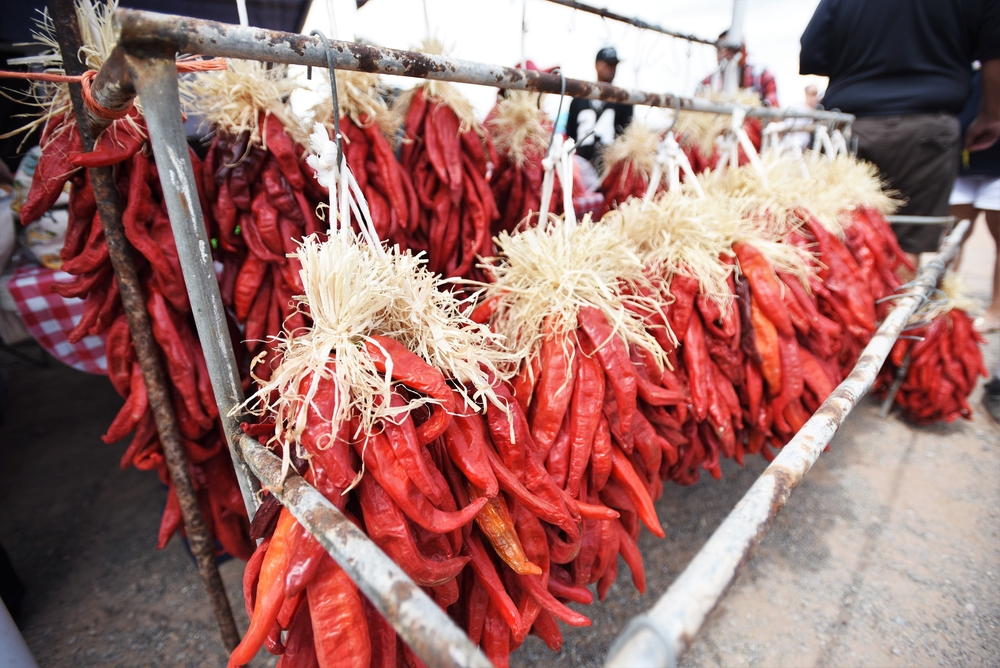NuMex Sandia pepper is a hybrid cross between Anaheim and New Mexico No. 9. This NewMex pod-type cultivar can grow up to six inches long and has a heat level of 5,000 to 7,000 SHUs.
What Are Sandia Peppers?
Sandia chile pepper was released in 1956 by Dr. Roy Harper. It was previously known as Sandia A but was renamed Sandia in 1967 by the New Mexico Crop Improvement Association.
Origins
Sandia peppers are capsicum annuum cultivars that originated in New Mexico. They are a hybrid pepper developed at New Mexico State University. They’re a cross between Anaheim and New Mexico No. 9 chile peppers.
Taste
Sandia peppers combine the heat of a New Mexico No. 9 pepper with the mild, sweet flavor of an Anaheim chile pepper. They’re sweet and spicy but not too hot.
Appearance
Like Anaheims, Sandia peppers are long and wide. They have thin walls and curve slightly at the tip. The thin walls pushed for the development of Numex Sandia select, a hybrid pepper with thick walls more suitable for stuffing.
Color
Like many peppers, Sandia peppers are green when immature and turn to a vibrant red as they mature. They’re mostly harvested when red for dehydration and ground into chili powder or used for decor in chile ristras.
Size
Sandia peppers can grow to 1.5 inches wide and 6 inches long.
Are Sandia Peppers Hot?
At 5,000 to 7,000 Scoville heat units, Sandia peppers are hotter than the average bell pepper but not as hot as cayenne or habanero peppers.
They have a sweet, fruity flavor similar to Anaheim peppers but with more heat.
What’s The Difference Between Sandia Peppers And Anaheim Peppers?
Sandia and Anaheim peppers’ main differences are their size, heat level, and harvesting time.
Anaheim peppers are larger than Sandia peppers. They can grow up to 10 inches long, while Sandia peppers are only about 6 inches long.
Sandia peppers have a higher heat level than Anaheim peppers. Sandias heat level starts at 5,000 and max out at 7,000. Anaheim peppers have a heat level of 500 to 2,500. Mild Sandias are ten times hotter than mild Anaheims.
While Anaheim peppers are usually harvested while green, Sandia peppers are typically picked when red and allowed to ripen on the vine. However, green Sandias are perfectly edible and are popular stuffing peppers.
Other than their size and heat level differences, the two peppers are very similar in appearance and color.
What Are Sandia Peppers Used For?
Sandia peppers are typically harvested when red because of their thin skin. The thin wall makes them perfect for dehydration and processing into powders, flakes, and sauce.
Their size and shape make them great for ristras, a common sight in New Mexico.
They’re also versatile enough for salsas, stir-fries, stews, and many other dishes when used fresh. They’re often used in Mexican and Southwestern cuisine, but their versatility makes them perfect for any cooking style.

Where To Buy Sandia Peppers
Sandia peppers are available at local farmer’s markets and grocery stores throughout New Mexico. They can be purchased fresh, canned, or dried.
If you live outside of New Mexico, it’s hard to find fresh Sandia peppers, but they’re available canned and dried online.
If your interest is fresh peppers, your best bet is to grow your own. Pepper seeds are available on Amazon and other online sources and are easy to grow in a home garden.
Substitutes For Sandia Peppers
If you can’t find Sandia pepper or feel a little adventurous, you can use a few substitutes:
- Anaheim peppers: Less spicy but sweet and smoky, these chilis are an excellent substitute for Sandia peppers.
- Jalapeno Peppers: Add some jalapeno chili pepper to make your dishes spicier.
- Cayenne pepper: Spicy and hot, but not as sweet as the Sandia pepper, cayenne will give your food a nice kick.
You can also use other NuMex chilis, like the new Sandia select and NuMex twilight peppers.
Can You Grow Sandia Peppers?
Yes, you can grow Sandia peppers. Here are some tips for getting started:
Start with good soil that is well-drained and rich in nutrients. Start your seeds in a warm location and keep them there until the plants begin to grow.
When your seedlings have 5-6 sets of true leaves, move the plants into an area that gets full sun but protect them from strong winds.
Fertilize regularly and keep them watered. Like all peppers, Sandia chilis need plenty of water to thrive, especially during dry spells. Just be sure not to overwater them to avoid root rot.
Air circulation around the plant will help promote even health and growth. Keep an eye on the plants for pests and diseases, and take action if problems develop.
The best time to start harvesting depends on what you will use the peppers for. For fresh eating, harvest when the peppers are green, firm and glossy but before they turn red. If you want to dry or can your peppers, wait until they turn a deep red color.

